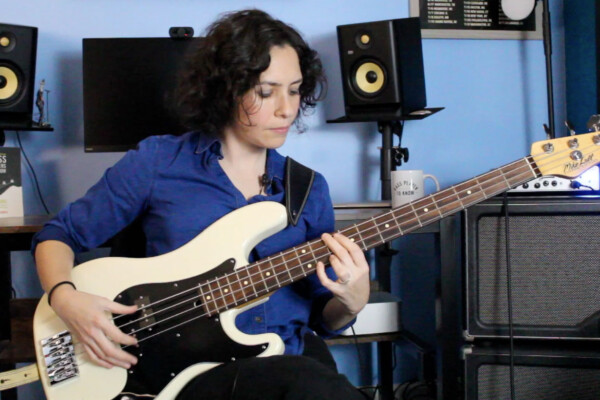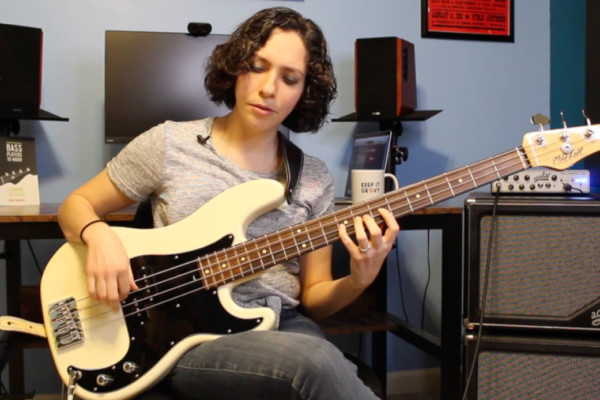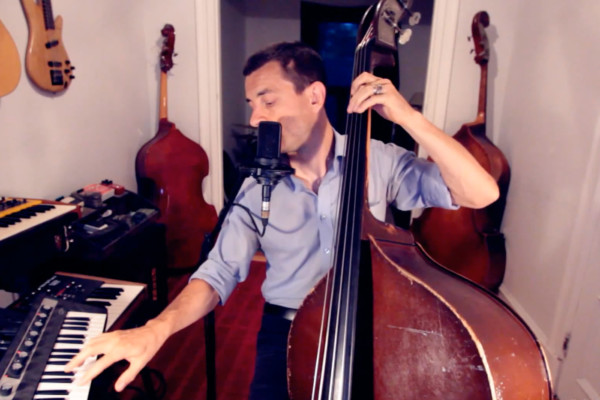Breaking Down Harmonic Substitutions: Part 1
Q: What are substitutions and how can I make use of them?
A: The first answer is easy: a substitution is using one chord in the place of another.
For example:
We might assume that a C Major chord symbol (CMaj7 or C?7) would imply a C major scale:
C D E F G A B C
But what if we substituted a G major scale for the C major chord?
This gives us:
G A B C D E F♯ G
There is only one note difference between them (F and F♯), but the result is two-fold:
- Since we have an F♯ in our substitution, when we play that on the C, it gives us the C Lydian mode. In jazz theory, a ♯11 is an available tension (or extension) on any major or dominant chord. Basically, if the scale has a major 3rd from the root, you can use a ♯11. This substitution gives us a harmonically richer sound without us even having to play a different scale (just change our root, and voilà, we can still think of the major scale, but get to make use of the fancy ♯11 at the same time.
- This technique also assists bass players in the quest to get away from root motion in our solos. Even though we are still playing over a C major chord, we can think G and our phrasing will sound different because we will be operating from a different place in the scale. We all have different shapes and patterns that we lean on when we play any given scale. When we keep our scale shape – but shift our root – we will likely adhere to our patterns, but now we’ll be emphasizing different scale tones set against the actual chord that we are playing over.
The big thing to be aware of is this: regardless of what scale or tonality you are playing in your mind, in reality, you are still very much playing over that C major chord. This means that when you resolve to your mental root, you are not actually resolving to the root of the chord. The same holds true for every relationship in the scale. You always have to remain aware of how the note you are playing will act against the actual chord you are playing over and not just the chord or scale that you have in your head.
When I first started working on playing through jazz changes, this was how I cheated “real” jazz harmony, which was still very much a mystery to me. I was only really comfortable with the major and minor scales, so I worked on ways to turn most any chord into a major or minor scale – with varying degrees of success. Major and minor scales just don’t cut it over many chord types in jazz music, no matter how hard you try.
Ultimately, we must also explore melodic minor and harmonic minor if we really want to expand our vocabulary. That said, this isn’t a bad place to start your explorations!
How would one do this? I imagined that the modes were on a clock face and for every chord type, I simply had to rotate the face until it gave me the major or minor scale that I wanted to play.
But keep this in mind: only some of these chord types will actually sound good when you do this. This was just the first step in my exploration. There are much hipper scales to use when making use of substitutions than I will list right here, but many of these are outside of the major scale harmony (i.e.: melodic and harmonic minor). This is just a way to start playing with the concept. I will give examples that draw upon all scale types for use over various chord types in my next installment.
| Chord | Options |
|---|---|
| CMaj7 or C?7: | As in the example given above, the quick and easy substitution is to play the major scale from the 5th of the chord. This give you a ♯11 (G Major = C Lydian) |
| C7: | You can play a Major scale from the 4th (C Mixolydian = F Ionian (or F Major) This means, however, that whenever you resolve to your substituted root (the F), you will be landing on a very ambiguous sounding note. This is why we have to remain aware of the chord we are actually playing over and how our note choices will ct against it. You can play a minor scale from the 5th (G minor gives you a C Dorian tonality. This means that you will be playing a ♭3 over the C7 chord. This usually works well enough, as it can sound bluesy. Often, the phrasing will make or break the line. You can play a Dorian scale from the 5th (C Mixolydian = G Dorian) |
| Cmin7 or C-7: | You can play a minor scale from the 5th (G Aeolian (minor) = C Dorian. This gives us a natural 6th on the Cmin7 chord which, is a common choice) You can play a major scale from the ♭7 (B♭ Ionian (Major) = C Dorian. Just like the G minor scale, this gives us C Dorian with the natural 6th) |
| Cø7 or C‑7(♭5): | You can play the Major scale up a half-step from the root. Again, this means that you will want to be careful with the root of your substituted scale. There is no more dissonant a note to land on than the ♭2, unless done in the right way. My preferred choice (in major scale harmony) is to play Lydian from the ♭5 G♭ (or F♯) Lydian = C Locrian (7th mode of D♭ Major) |
Note: Locrian was the scale of choice for quite some time over half-dim chords (-7(♭5)). This became less the norm in favor of the use of 6th mode of melodic minor (literally, a minor scale (aeolian) but with a ♭5. Often referred to as Locrian ♯2 as well.) The only real difference here is whether or not to use a ♭2 or natural 2 on the -7(♭5) chord. ♭2 preference = Locrian (7th mode of the major scale) and a natural 2nd = Locrian ♯2 (6th mode of melodic minor).
From what I understand, Bill Evans made the use of a natural 2nd over this chord standard by virtue of the way he voiced minor ii-V’s. His natural 2nd over the ii-7♭5 would resolve down a half-step to the ♭13 of his V7♭9, and then down again to the natural 9 of his minor i-7 chord.
If you don’t know what I’m talking about there, don’t sweat it. That’s the kind of talk that freaked me out for years until I began to understand it. Just work in bite-sized chunks, and you will slowly begin to understand the verbiage. Don’t let the words scare you, it’s all pretty easy to understand nice you have a grip on the fundamentals.
All of that was to say that the most common substitution for this chord type is to play melodic minor from the ♭3. (C Locrian (with a natural 2nd) = E♭ melodic minor)
This is quite a bit to start with and the best way to practice this stuff is to break out your Real Book and practice playing through tunes slowly.
1. Practice playing your substituted scale in time over each relating chord change.
When you see this:
|| Dmin7 | G7 | CMaj7 | CMaj7 ||
play this:
|| Amin | Dmin | GMaj | GMaj ||
…or any kind of substitution that you want to try.
It’s pretty important that you explore this stuff with a playback of some kind – or other musicians – as you really need to hear how it sounds. Just because it works in your head, doesn’t mean that it will sound good in practice. For everything you find that works, you’ll discover two things that don’t work as well. Keep a log of what substitutions sound good to you (I’ll include mine here at the end of this column).
Let’s stop it here so you can all explore this stuff. Once you get the concept in your mind, it’s easy enough to start trying things, and then it’s just a matter of trial and error and keeping track of what you like.
Here is my list of substitutions I keep on my computer’s desktop (yes, I keep it in a “sticky” on my desktop)…
Alternate harmony options:
Keep in mind that I use symbols for chord symbols:
? = Major
– = minor
| Chord | Options |
|---|---|
| ?7 | ?7 from the 5 (makes it Lydian) |
| 7 | min penta from the 5 mel min from the 5 (adds a ♯11) Dorian from the 5 |
| -7 | -7 from the 5 ?7 form the ♭7 |
| ø7 | Lydian from ♭5 minor from the ♭7 Mel min from the ♭3 Mixo ♭6 from the ♭7 (5th mode Mel min) Harm min from the ♭7 |
| SUS4 | minor Pentatonic from 5 ? from 4 |
| alt | Mixo ♭2, ♭6 (harmonic min) down ?3 and Mixo ♭6 (melodic min) 1/2-wh from root, ♭3, ♭5 or 6 |
| o7 | altered scale (of choice) from ?7 (diminished is alt dominant from the ♭9) wh-half sym dim |
| ?7 ♯5 | 3rd deg of Harm min or mel min mixo ♭6 from the 3 (mel min) |
| -(?7) | Melodic OR Harmonic min mixo ♭6 from the 5 (mel min) mixo ♭2 ♭6 from the 5 (harm min) |
| 7(♯11) | mel min from the 5 Lydian Dominant (mel min) mixo ♭6 from the 2 (mel min) |
| 7(♯5) | Whole Tone |
| sus7(♭9) | mel min from ♭7 |
- Any extension immediately implies a ♯11
- ♭9 implies ♯9 and vice-versa
- any chord with a ?3rd can have a ♯11
If there is anything in there that you don’t understand (like my shorthand), worry not. I will explain all of these options in the next installment!
If you have any questions or other ideas to share, I’d love to hear them. Please post those in the comments section below.
Have a question for Damian Erskine? Send it to [email protected]. Check out Damian’s instructional books, Right Hand Drive and The Improviser’s Path.




Great explanation of a question I had been wondering myself for a while. I’ll be certain to reference this for practice and jamming tonight.
this… i’ll need a few weeks to go over so much material :D THANK YOU!!!
im ot sure I understant G dorian = C Dorian, I think it might be a mistake
You’re right!! That should say C Mixolydian = G Dorian. I’ll ask them to to fix that. Thanks for spotting that!
One thing I’ve been working on and also been pushed to try is to use extended harmony by only using chord tones as the basis for your melodic material–all other harmonic content either being diatonic or chromatic (or somewhere in between). This was most utilized by the bebop-ers and is starting to reappear in the sounds of modern jazz like Ambrose Akinmusire, Walter Smith III, David Binney, etc. This opens you up in some ways to the entire range of the 12 notes in music, but also the superimposition of non-traditional scales like Harmonic Major, Melodic Minor with #5, etc. So knowing those chord tones is imperative to exploring some sounds outside the normal realm of possibility. And using those scales/patterns and understanding how chord tones are common in between certain scales/patterns will further your knowledge of substitutions and on a basic level, your understanding of music.
Great lesson but feels like a lot to take in. I’m certain I will be chewing on this for weeks if not months.
Thank you!